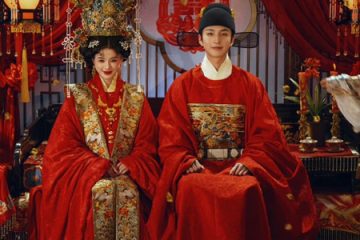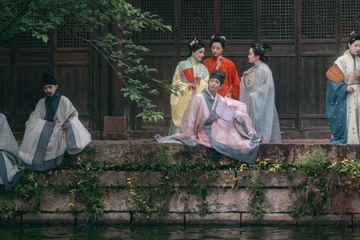How Did Ancient Chinese People Engage in Sports

Archery, equestrianism, wellness practices, football, golf… Do you think these sports only gained popularity in the modern era from the West? In fact, ancient China had similar activities long before, hundreds or even thousands of years ago. For example, cu ju was the precursor to football, and chui wan was an early form of golf. However, ancient China didn’t have the word “sports” as we know it today, yet various physical activities were deeply embedded in society. This blog will explore some interesting facts about ancient Chinese sports, hoping to present a vivid picture of a sporting China.
Cuju (蹴鞠)
Cuju was an ancient Chinese ball game, often regarded as the precursor to modern football, and it marks the beginning of the world’s football history. It played a significant role in Chinese imperial court performances, military training, and popular entertainment. During the Tang and Song dynasties, cuju flourished thanks to advancements in the technology of inflatable balls. However, it began to decline in the Ming dynasty and eventually faded into extinction by the mid-Qing dynasty.
“The kicked leather ball soared repeatedly higher than the flying birds, while the swings swung out in competition from the lush willow trees. (蹴鞠屡过飞鸟上,秋千竞出垂杨里)”

According to historical records, as early as the Warring States period, a form of recreational cuju was popular among the people. From the Han dynasty, it evolved into a military training method, and during the Tang and Song dynasties, cuju organizations known as “Yuan She” (圆社) emerged, with many cuju artists and professional teams. By the Qing dynasty, a variation of cuju, played on ice, became popular. Thus, it can be said that cuju is one of the most enduring and influential sports in ancient China, a true gem in the history of Chinese athletics.
Polo
Polo is a sport played on horseback, where players use mallets to hit a ball into the goal. It is also recognized as one of the national intangible cultural heritage items.
“The thunderous sound of hooves from a hundred horses presses close, while the warriors’ cheers echo from all directions like a thunder.(百马撵蹄近相映,欢声四合壮士呼)”

Polo originated in Persia (modern-day Iran) around 525 BCE and was later introduced to China. Polo had already existed in China by the late Western Han Dynasty, making it over 2,000 years old. It flourished during the Tang, Song, and Yuan dynasties, primarily popular among the military and the aristocracy of the imperial court.

Polo is a sport that emphasizes coordination and control, requiring the perfect integration of the rider, horse, and mallet, with a strong focus on skill. As a sport long favored by royalty and the elite, it can be considered a true “noble sport.” Many polo players describe it as a blend of equestrianism, golf, and soccer, suggesting that mastering polo is far from an easy task.
Chuiwan(捶丸)
Chuiwan, as the name suggests, involves striking a ball with a mallet. It is one of the ancient Chinese ball games of the Han ethnic group. The earliest record of Chuiwan appears in a work titled Wan Jing (丸经), written by an author named “Ning Zhizhai”(宁志斋) in the 19th year of the reign of Yuan Shizu (1279). This book specifically discusses the game of Chuiwan.

The precursor to Chuiwan was the “bu da qiu (布打球)” played during the Tang Dynasty as part of polo. This game was similar to modern field hockey, involving strong physical competition.
Chuiwan also became a popular leisure activity among the scholar-official class during the Ming Dynasty, with many enthusiasts taking to the sport. As the proverb says:”好事者多尚捶丸”, it shows people with certain hobbies often admire and engage in the sport of Chuiwan.
Since it was not physically demanding but still provided benefits such as “calming the mind, nourishing the blood, and delighting the spirit” (from 《丸经·序》), it became one of the favored pastimes for women as well.
Archery
In China, recent archaeological discoveries have revealed that as early as 28,000 years ago, at the Zhiyu site in Shanxi, arrows were already in use. This indicates that humans had begun to use bows and arrows at that time. The arrowheads were made from stone and attached to wooden shafts, serving as the tools for archery during that period. Figures like Confucius, Xunzi, and Mozi were known to be archery enthusiasts, and they not only practiced archery themselves but also encouraged their students to engage in it as part of physical training.
In Han dynasty literature, archery is a recurring theme, with phrases like “shooting tigers” and “shooting pheasants” commonly appearing. Additionally, Han bamboo slips record activities like “autumn archery,” suggesting that archery had already become an integral part of daily life and culture.

The image below shows an archery “trophy” from over 3,000 years ago–the Zuo Bo Bronze Gui (柞伯铜簋). It commemorates an archery competition held by the Zhou king in Haojing, where participants were divided into two groups, and ten pieces of red copper were awarded as prizes. Before the competition began, the king issued a command, urging contestants to compete with caution and humility. The person who hit the most targets would win the prize. During the contest, Zuo Bo (柞伯) successfully hit all ten targets and was rewarded. He then crafted this bronze vessel from the ten red copper discs as a keepsake, which resembles the modern-day trophy.

Shuaijiao (摔跤)
Shuaijiao, means Wrestling, known as “jiāolì” (角力) in pre-Qin times, was primarily used for military training and was also referred to as hand-to-hand combat or grappling. It is an activity where individuals use their own strength, without any tools, to conquer opponents, making it one of the most primitive and earliest forms of sport. Wrestling exists in various forms around the world, both in the East and West, and across different cultures. It is a combination of skill and art. In competition, wrestlers need quick reflexes, effective use of muscle strength throughout the body, as well as a focus on the beauty and fluidity of their movements, offering an aesthetic experience to the audience.

Shuaijiao began to be a form of entertainment during the Qin Dynasty. In the Han Dynasty, it took on more professional characteristics. Over time, it evolved and by the Ming and Qing Dynasties, it became widely popular among the general public and was embraced as a commonly accepted folk activity.
Dragon Boat Racing
Dragon Boat Racing, also known as 赛龙舟 or 划龙船, is an important tradition in China that is still practiced today during the Dragon Boat Festival. According to archaeological evidence, the earliest form of dragon boat racing appeared during the Spring and Autumn period. During the Warring States period, people carved single-log boats into dragon shapes and raced them to the rhythm of drumming. It was a sport that combined both religious and recreational elements, offering entertainment while honoring the gods.
Swimming
Swimming was one of the most popular and widespread water sports in ancient times. The earliest description of swimming can be found in the “Book of Songs” (Shijing), which says, “就其深矣,方之舟之,就其浅矣,泳之游之。” This indicates that If the water is deep, one uses a boat to cross; if the water is shallow, one swims across.
The development of swimming can be traced back to the ancient practice of bathing, which gradually evolved into water play and eventually led to the formation of swimming as we know it. On the “Banquet and Hunting Scene Copper Pot”(《宴乐渔猎攻战纹铜壶》) from the Warring States period, there are images of people swimming alongside fish.

During the Tang and Song Dynasties, large-scale swimming competitions were held every year on the Qiantang River during the Dragon Boat Festival, and tidal swimming (swimming with the tides) became a popular form of public entertainment. Professional performers emerged, and the term “弄潮儿” (literally “tide player”) was coined during this time, referring to someone who dared to break tradition, boldly try new things, or lead in a certain field. Many scholars in the Song Dynasty were deeply impressed by the “tide players,” praising them as worthy of admiration for their ability to conquer the sea.

Conclusion
The saying “life lies in movement” is a universal truth that holds across the world. The hardworking and wise ancients not only cultivated their emotions through poetry and literature but also, in their spare time, invented many sports that reflected another side of their love for life. After a long period of development, some of these sports traditions have gradually faded away, but others still shine in different forms today. Which of these sports do you like the most? Feel free to leave your comments below!



0 Comments